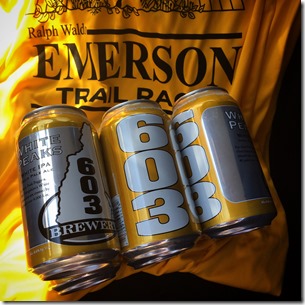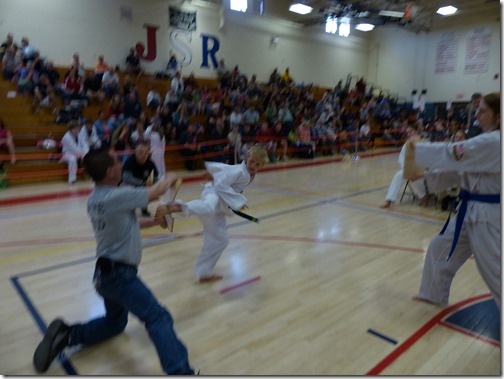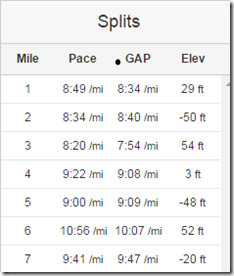Sometime last year I decided that it was time to step away from the marathon for awhile and focus on shorter, faster races. I love marathons, but the training cycles had become a grind, and I was tired of focusing all of my effort on only one or two races per year. I have also come to realize that my body seems better built for shorter distances – I’m not a huge guy, but I have a large frame, and running fast for 26.2 miles typically knocks me out for quite a long time. I needed a break.
About a month ago I started training hard again under the guidance of my coach, Caleb Masland. I wanted an early-season test of my fitness, so I started looking for a local 5K. It was an interesting experience. I hopped on Cool Running to look at the local race schedule, and as I scanned the list of options my blood pressure started to rise. My heart was pounding and I had butterflies in my stomach. I was a little bit afraid, and I’m not ashamed to admit that. It had been a long time since I’d raced a 5K – well over a year since my last 5K road race. My primary recollection was that racing a 5K hurts. Really bad.
5K races hurt in a very different way than marathons hurt. You can run a marathon at what feels like a relatively moderate pace for most of the race. Pain doesn’t set in until around mile 18, and the pain is not like that experienced in a 5K.
In a 5K I tend to go out fast and focus all of my efforts on hanging on. It’s about managing the hurt and resisting the urge to slow down. It lasts only about 20 minutes if all goes well, but it’s 20 minutes of struggle. I was afraid of the pain because it had been so long since I’d last experienced it.
I lined up at the starting line of the SEA 5K two weeks ago without a strong sense of what I was capable of. I’d run through the winter, but not big miles and mostly at a pretty leisurely pace. I told myself I’d be happy with sub-20:00, so that’s what I aimed for. True to form I went out really fast. Well under 6:00/mile pace for the first half mile or so. I felt good, but it was just the adrenaline carrying me along. I slowed down a bit as the hurt started, and finished the first mile in 6:05.
Since I had set a “happy” goal of sub-20:00, I knew the average pace I needed, so I let myself succumb to the pain and slowed down in mile two – 6:34. As long as I came in below 20:00 I wasn’t going to be upset. I managed my pace accordingly
Pain intensified in mile 3, but I held on and sped up just a bit for a 6:21. At that point I knew I had my goal in hand, and I finished strong for a finish time of 19:43.
Overall I was happy with the race result, but I was 50 seconds off my PR, and I knew I had hard work ahead of me to chip almost a minute off my time.
I had tentatively planned to run another 5K two weeks later, but was wavering since it was an evening race and it would have left my wife home alone for diner with the kids two nights in a row. I had even told Caleb that I wasn’t going to race. But, my Taekwondo studio was a race sponsor and Master Jung wanted me to run as part of the studio team. Being an obedient student, I agreed.
The morning of the race I got an email from Lynn Jennings asking for some info for the Craftsbury Running Camps this summer. I mentioned that I was running a 5K later in the day, and she shot back an email with the the following line of advice: “Run strong and don’t ‘save’ anything for the last mile – it comes up too quick!” I figured advice from an Olympic medalist is worth listening to, and that line became my mantra heading into the race.
The course was similar, mostly flat with a lot of turns, but it had a big overpass that needed to be crossed twice. I thought the little hill might make things a bit slower, but I didn’t really have a goal time. I actually wasn’t feeling great before the race, almost fell asleep on the couch at home beforehand.
Once I got to the race location things perked up a bit. Saw a bunch of local running friends, including a number of people I’ve gotten to know via working with them in the clinic. It’s been a long time since I’ve felt a connection to my local running community, and it feels great to be getting into the local race scene again.
The gun went off, and just like the previous race I went out fast. This time I held on for a 5:58 first mile, and I kept thinking about what Lynn had said. I wasn’t going to back off to the extent that I did in the previous race – my goal was to hold a comfortably painful pace for as long as possible and hammer at the end if I had anything left. I ran miles 2 and 3 at right around 6:14 min/mile pace, and I think the overpass actually helped to mix up muscle usage in my legs.
Toward the end of mile three I was pretty sure sub-19:00 was going to be possible, and I was rather shocked. I hammered the final 0.1 at 5:26 min/mile pace, so I may have even had a bit left in the tank. Crossed the finish in 18:53, which is two seconds off my PR. Second in my age group for the second consecutive race, and I was thrilled with the result.
So the big question was how the heck did I shave 50 seconds off my 5K time in two weeks. I don’t think it was the course, as both are flat, measured courses and the races are both well-attended annual events and are part of a local race series. I don’t think I had gained 50 seconds worth of fitness in two weeks (maybe a little, but not that much). I don’t think the Saucony A6’s on my feet were that much faster than the Pearl Izumi N0’s that I wore two weeks prior. I think the biggest change was mental.
My approach to the first race was “Run under 20:00 and you’ll be happy.” So I moderated my effort to make sure that I came in under 20:00, but I didn’t strain. In the second race I kept thinking about what Lynn had said. My approach was more “Go out hard and hang on as long as you can.” Didn’t really have a goal time, just wanted to not ease off as much in mile two. And it worked. I broke the race up a bit more into segments, and once I got through mile two and realized that I was hurting but doing ok, I kept plugging along and finished strong.
I think what I’ve learned here is that setting race goals in the form of a set time can lead you to ease off so that you just beat the goal you choose. Your brain moderates your effort to meet the goal and doesn’t allow you to run your best. You’ll be happy, but you may not be satisfied.
However, much like I ran my breakthrough marathon at Disney in 2010 in a race that I entered with no goal but to have fun, the 5K on Friday was one that I entered with a sole goal of running hard and holding on. That approach gained me 50 seconds, and hopefully will lead to a PR in the coming months. It’s a PR that has existed since 2008, and it’s time for it to go down.



















Good job! Now, let’s talk about those A6s…
Fantastic in the race, my worries about them being too narrow unwarranted.
Congrats on the near-PR! There was a study mentioned in Runner’s World (I think) that seemed to demonstrate that in trained athletes (I think the subjects were HS-age women), those who went out 6% faster than goal pace ran faster than those who went out at goal pace. (Those who went out 3% faster than goal pace also tended to run faster than the ‘control’ group, but not as significantly.) I, too, have had quite a bit of success adopting this tactic, even when I’ve bonked a bit. As a running friend (and one-time <14:45 5k runner) phrases it, grind and then settle in, relax, and roll.
The adrenaline makes that first quarter mile or so feel effortless, but it catches up quick after that. But I just can’t seem to hold myself back in a 5K like I can in a marathon, the race is too short!
It’s relentless, isn’t it? I always feel like I’m straddling the line between a threshold aerobic effort and an anaerobic one. You will have no problem crushing your PR, though, I’m sure. Keep us updated.
Thanks Matt!
Great post. Have a 5K coming up, and would love to break 20 min. (PR is 20:12). Don’t know if I’m brave enough or fit enough now to take your advice to go out fast and hang on, though.
Only one way to find out!
OK, that’s the worst advice ever. At the 1st mile marker, the lady yelled out “5:49!” to me. I wondered if I could keep it up. Ummm, no… Ended up finishing in 21:01. It’s not about being brave, it’s about being in shape and knowing what pace you can realistically hold. Shoulda stayed around 6:30 and kept it conservative. That was my plan during my PR several months ago and it worked great.
Being brave does not mean running a pace way faster than your fitness can handle. It means not letting yourself run at a pace slower than your fitness is capable of running. Important distinction. If I tried to run a 5K at 5:30 min/mile pace I’d crash and burn hard.
And you also have to realize that mile 1 may be a bit faster due to the adrenaline rush at the beginning, some slowdown is inevitable if you ride that wave.
Great post Pete. A really good read. Congrats on the almost PR!
Thanks Kevin!
A good approach to life, and running.
Hi Peter,
have you ever tried to run a 5k on a track?
It really changes your feeling, the pace being the only thing to care about.
No, but I was thinking about that the other day. My sense is that it would be a serious challenge from a mental standpoint!
The only way to find out how fast you can go is to just go for it and hold on for dear life. It’s easy to do that with a 5k, provided you are willing to suffer. That approach works up to a half-marathon, which requires about the same amount of calories as your body stores from carbs (for those of reasonable weight/fitness). A couple sips of Gatorade and bonking isn’t really possible at all. If you want to run to your true potential, you have to be brave and be willing to suffer.
Optimum marathon performance is about burning the perfect mix of calories from fat and carbohydrate stores. Your marathon potential happens when your body exhausts carb stores just as you cross the finish line – so managing carb stores with even or close negative splits are paramount, especially at the elite level. For any shorter distance, the rest of us mortals just don’t know what we’re really capable of doing, so trying to run like an elite marathoner means you’re leaving something on the table.
It is interesting – the marathon and beyond is a different beast because the fuel factor becomes a critical consideration. Shorter and longer races each present their own challenges, which is part of what makes doing both fun.
Ok, so I read this article this morning and thought to myself, Hmm… worth a try. So at tonights cross-country 5k race (part of our weekly 5k race series.) I went for it. Out the gate, hard as reasonably possible, and hung on for dear life. The result, 39 seconds faster than the time on the same race 2 weeks ago.
Thanks for the tip!
Congrats!
did you warm up the same on both races? if so, what did you do?
Yes, same for both. I usually do about a mile easy with a goal to finish it about 10 minutes or so before the race starts, then some light static and dynamic stretching.
Mental attitude is an important factor in all races, and if you want to run your best in short races then you have to expect and accept a level of pain and endure it.
Aside from the difference in mental attitude it is also possible that your body tuned up between races, even if the basic aerobic+anaerobic aspects to your fitness are little different. Elements like muscle tension can be altered by training and racing, short races you want higher muscle tension for a short time on stance.
Another factor can be the recalibration of your central governor. If you have done a recently similar race your central governor will learn from it and will know a little better how to gauge hot much stress is safe to endure. In subsequent races it may relax the red-line limits and not present so much fatigue for a given pace.
I’m betting on my central governor in this case :)
I just found your blog this morning, so I apologize if you’ve covered this before – but have you ever raced a 5k without your watch? Do you think it would help you or hurt you to run solely on effort?
Have not tried it, but great question. No idea if it would be better or worse!